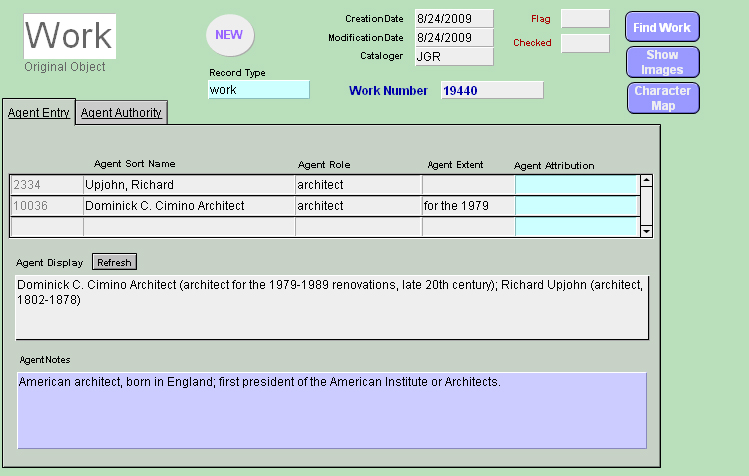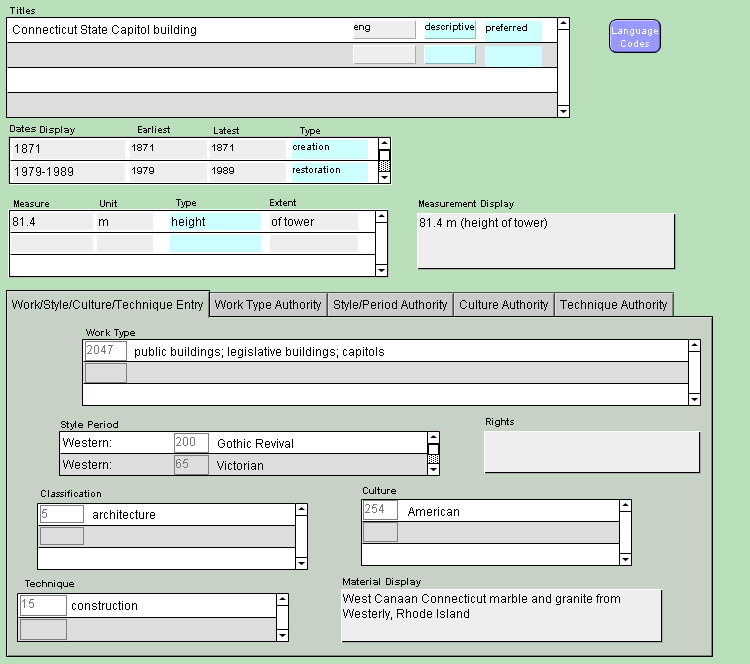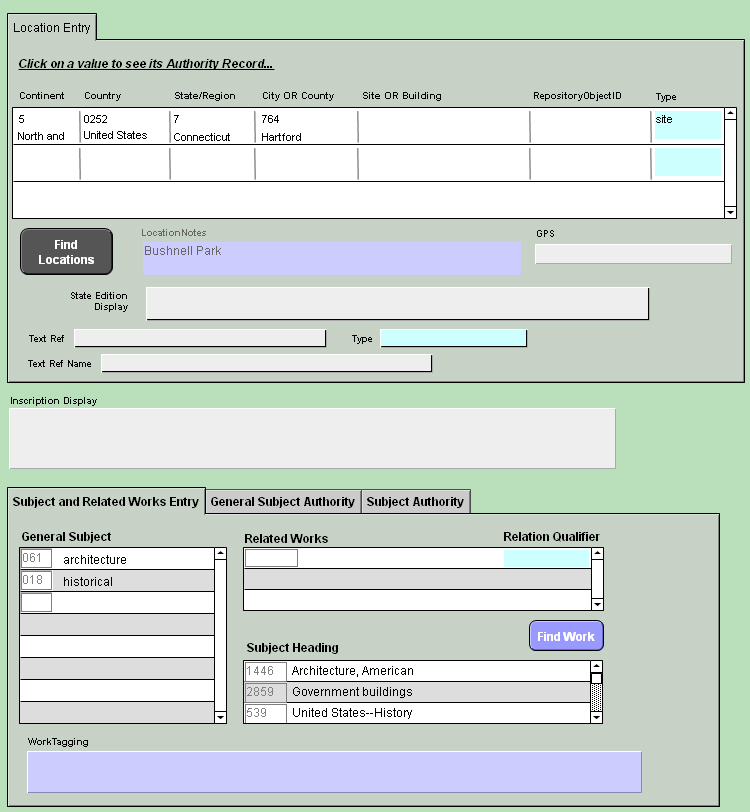Vcat
Best Practices:
Work and Work Tabbed
The Work layout is where you decribe the work pictured in the image in detail, and thus it is a very long form. Most of the fields in the layout link directly into the Authorities layouts and appear in fields called portals. Most of the time when entering information into a portal, you are not actually entering information into the Work Table, but into the Authority Tables or Transitional Tables (which are invisible to the Catalogers.) The Work layout ties different fields from these Tables together so that when a record is exported, it draws information from almost every Table in Vcat.
There are two layouts for Work: Work and Work Tabbed. They contain the same fields, they just look different. VRC Staff have historically used the Work Tabbed layout (pictured below) and have arranged the field in a logical order for cataloging. It is recommended that Catalogers use Work Tabbed not only beceause of the reordering of the fields, but also because the Authorities are available from within the Work Tabbed layout for easy searching. Agent Entry, for example, is where you select the names of the people of groups involoved in the creation of a work. Clicking on the Agent Authority tab brings up a truncated layout similar to the Agent Authority layout.
The images below for the Work Tabbed layout have been split up for easy navigation. They appear as one large layout in Vcat.
New button: Created a new, blank record
Find Work button: Opens a new window with the Work layout in Find mode
Show Images button: Opens a new window with short records of all Image records associated with the Work record
Character Map button: Opens the Windows Character Map program for easy insertion of diacritics
Refresh button: Refreshes the Agent Display
Language Codes button: Opens a web page with three-character language codes
Find Locations button: Opens a new window with a locations finding tool
Set Date button: Sets the Source Access Date to the current date

| Field Names | Local Usage | Notes |
|
Creation Date |
Auto-generated |
|
|
Modification Date |
Auto-generated |
|
|
Cataloger |
Pull-down menu |
Entries from the Cataloger Table |
|
Flag |
Pull-down menu |
Use to bring the Work record to the attention of the Staff. Please inform the Staff when you have Flagged a record. |
|
Checked |
Pull-down menu
|
Used only
by Staff
|
|
Record Type |
Pull-down menu |
A Work record can be classified as Work or Collection. Use Collection if you are cataloging a number of objects together. |
|
Work Number |
Auto-generated |
The Primary key for the Work facet |
|
Agent |
Pull-down menu,
alphabetical by last name |
Lists the persons or corporate entities that contributed to the work. Entries from the Agent Table. This is a long list and can take some time to load. If you know someone should be on the list but you can't find them, search the Agent tab or layout. |
|
Agent Sort Name |
Auto-entered when Agent is
chosen |
|
|
Agent Role |
Pull-down menu; See Staff
if a new role is needed |
Required field. Roles can be added to the list with Staff approval. See ULAN's Roles list for possible entries. |
|
Agent Extent |
Free text, use all lower case |
Use only if the Agent is responsible for one aspect of the creation of the work. For instance, Saint Peter's Basilica in Rome has a number of architects listed, each responsible for different parts of the building. The Agent Display will string together the Role and Extent fields, so use connecting words: "architect" (Role) "of dome" (Extent) will appear as "architect of dome". |
|
Agent Attribution |
Pull-down menu |
Use when their is some doubt about attribution, or if the creators unknown but associated with a particuar person. |
|
Agent Display |
Press Refresh button to
update |
PLEASE refresh the Agent display everytime you change the information in the Agent Entry. This is vital for the export. |
|
Agent Notes |
Auto-entered from Agent Table |
The Notes field from the Agent Layout for the first name you enter will appear. It does not export. |

| Field Name | Local Usage | Notes |
|
Titles |
Use Title Case or as source or capitalize first letter
of descriptive titles; one title per line with variations |
English titles should be the preferred title according to CCO. Don't be afraid to use multiple titles--you may add as many as is necessary. |
|
Title Language |
Pull-down menu, editable |
Additional language codes may be added by scrolling to the bottom of the list and clicking "Edit". Please put new additions in alphabetical order. |
|
Title Type |
Pull-down menu |
Desribes the origin of the Title. If you make up a title, use "descriptive". |
|
Title Preferred |
Pull-down menu; ONE titled
must be preferred |
One and only one title MUST be preferred |
|
Date Display |
Use yyyy-yyyy format; use
yyyy, dd month format; use “CE” or “BCE” for first two centuries with space, i.e. “323 BCE” |
Use multiple lines for separate dates, with Date Type. More specific information about the dates can be added to the Description. |
|
Earliest Date |
Use yyyy format with leading “0”s
if necessary; express BCE years in negative numbers, i.e. “–0323” |
|
|
Latest Date |
As Earliest Date |
|
|
Date Type |
Pull-down menu |
This field cannot be modified--pick the closest match |
|
Measure |
Use numbers or "ca." |
List dimensions singely. |
|
Unit |
Pull-down menu |
|
|
Type |
Pull-down menu |
|
|
Extent |
Pull-down menu |
Use if there is more than one dimension of the same Type. Use connecting words: "35" (Measure) "m" (Unit) "height" (Type) "of tower" (Extent) with "27" (Measure) "m" (Unit) "height" (Type) "of dome" (Extent) |
|
Measurement Display |
Use
spaces between elements with multiple dimensions; use
units from Unit field; for single dimensions use number and Unit with Type
and Extent following in parentheses; i.e. “12 x 5 x 4 cm”
or “15 cm (diameter)” Use commas between strings.
|
Should reflect the Extents, i.e. "35 m (height of tower), 27 m (height of dome)" |
|
Work Type |
Pull-down menu from
WorkType Table |
Describes what the work actually IS. Use as many lines as necessary. It is usefull to search for other Work records of similar objects to see what other Catalogers have used. |
|
Style Period Presort |
Pull-down menu from
StylePeriod Table |
This field is used to split the long list of Style/Period into navigatable chunks. It does not export, so a Style Period MUST be used. |
|
Style Period |
Pull-down menu; portal |
Describes the style, period, movement, school or dynasty in which the work was created. If you cannot find a term, search for it in the StylePeriod layout--it may be under another Presort term |
|
Rights |
Free text as needed |
Copyright information about the work should appear here. DO NOT include copyright information about the IMAGE. |
|
Classification |
Pull-down menu |
A broad keyword that is used n conjunction with the WorkType to describe the work. More than one term may be used. |
|
Culture |
Pull-down menu from
Culture Table |
Can be related to the nationality of the Agents, the country in which the work was created of located, and/or the social context of the creation of the work. |
|
Technique |
Pull-down menu from
Technique Table |
Documents processes that contributed to the creation of the work. |
|
Material Display |
Free text, use source |
The actual materials use to create the work, as differenciated from the Technique. Technique and Material Display are exported together. |

| Field Name | Local Usage | Notes |
|
Continent |
Pull-down menu from
Continent Table |
The Locations hierarchy can be used to pinpoint the physical site of a work, where it is kept, where it was found or created, where it was exhibited, or refer to the location of the original if the work is a map or diagram. Further information can be added to Description or Location Notes. |
|
Country |
Pull-down menu from
Country Table |
|
|
State/Region |
Pull-down menu from
StateRegion Table |
|
|
City OR County |
Pull-down menu from
CityCounty Table |
Includes archaeological sites not associated with a city |
|
Site Institution OR Building
|
Pull-down menu from
SiteInstitutionBuilding Table |
Includes archaeological sites associated with a city, and repositories |
|
RepositoryObjectID |
Pull-down menu from
RepositoryObjectID Table |
|
|
Location Type |
Pull-down menu |
This field is unmodifiable--choose the closest match. Further information can be added to the Description or Location Notes. |
|
Location Notes |
Free text |
Use
for any information that does not fit into hierarchy
|
|
GPS |
Latitude
Longitude in decimal degrees; use +/- |
|
|
State Edition Display |
Free text |
Records information about printed materials |
|
Text Ref |
Free text |
Use for
ms ff, catalog, page or plate numbers
|
|
Tex Ref Name |
Free text |
Use for ms shelf marks, catalog or bibliographic references related to Text Ref
|
|
Text Ref Type |
Pull-down menu |
|
|
Inscription Display |
Free text; as source |
Use to record any text on the object itself, including signatures. |
|
General Subject |
Pull-down menu from
GeneralSubject Table |
Use to describe what the work is about or depicts. General subject is a tightly controlled vocabulary. Additions to the list MUST be appoved by the Staff. |
|
Related Works |
Enter Work record number
of related work |
Enter the Work Numbers of related works. This necessitates Work records that may not have any Image records attached to them. |
|
Relationship Qualifier |
Pull-down menu |
|
|
Subject Heading |
Pull-down menu from
Subject Table |
Use to describe what the work is about or depicts. Can be expanded using the Subjects layout. |
|
Work Tagging |
Keywords separated by a
comma |
Intended for keywords for which no authoritative Subject heading can be created. |

| Field Name | Local Usage | Notes |
|
Description |
Free text; as needed |
Use for any information that is not included in the other fields. You may use the Description field to further explain other fields' data. |
|
Description Source |
Pull-down menu |
The source of the metadata you are using to catalog the work. Entries are from the Source layout, but clicking on the field will allow you to enter other sources. If you are updating an old record with information from a new source, use a new line for the new source and click the Set Date button. |
|
Source Access Date |
Press Set date button to
refresh |
The date the record was last added to. |
|
Record Source |
Auto-entered |
Continue
to Image